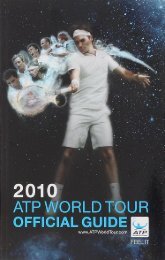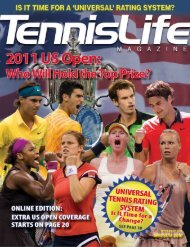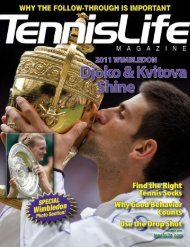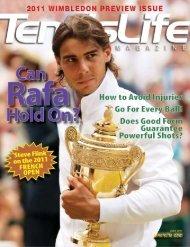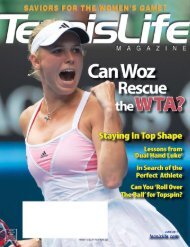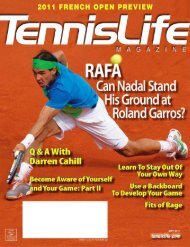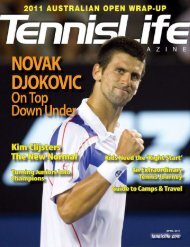A Champion's Mind - Pete Sampras
www.tennismoscow.me Insta:TENNISMOSCOW
www.tennismoscow.me Insta:TENNISMOSCOW
You also want an ePaper? Increase the reach of your titles
YUMPU automatically turns print PDFs into web optimized ePapers that Google loves.
messing around, trying to get that stupid little string and tag off the button on the new shirt.<br />
I had a thing about tennis shoes, going all the way back to the time I paid dearly for changing to the new<br />
Nike Air models. Clothing and shoe companies often wanted you to switch to shoes that matched<br />
whatever line they were promoting, but I wouldn’t have it. When I found the Nike Air Oscillate, which<br />
was pretty light but had good stiffness and support, I stuck with it. Nike sold plenty of them, too.<br />
All the shoe manufacturers make special shoes for the grass-court pros, ones with a grid of little stubs<br />
on the bottom. They were like soft, tiny cleats. I didn’t want the stubs to get too low (from wear), but I<br />
also didn’t want to wear a new pair of shoes for every match, like some guys did. In general, I loved<br />
wearing worn-down shoes on most courts, but not on grass. So I would take a new pair of shoes, practice<br />
with them, and play one or maybe two matches wearing them. Then I would throw that pair away and<br />
break in a new one. So the most wear I got out of a pair of shoes at Wimbledon was one practice and two<br />
matches.<br />
With Nike, it was important to stay on top of the company because as they changed lines and factories,<br />
you just never knew what you would get, sizing-wise. Jim Courier and I used to piss and moan about that.<br />
We’d say, “Do what you want to the color or pattern, but don’t change the length of the hem on the shorts<br />
or the cut of the foot bed in the shoe.” Sometimes I’d get a batch of shoes that came from a different<br />
factory than the last batch, and I could barely get my custom-made orthotic inserts into them. Of course,<br />
top pros tend to be more particular about things like the precise fit of their shoes or clothing, and we must<br />
have driven the Nike guys to distraction with our quibbles. Perhaps surprisingly, they didn’t make custom<br />
shoes for us.<br />
I was almost never hassled in Wimbledon Village. One time a couple of kids came to the door and<br />
knocked, asking for an autograph, which I happily gave them. Each day, I’d just call the All England Club<br />
for my courtesy car, and in moments it was there. It took all of five minutes to get to the club to practice or<br />
play. The club itself was very cozy, even after the renovation binge in the late 1990s. The tradition there<br />
until the remodeling was that they had two locker rooms—a fairly big, well-appointed one for the seeded<br />
players (the “A” locker room), and a smaller one that wasn’t even part of the main clubhouse/Centre<br />
Court complex for the journeymen, juniors, and others.<br />
I made it into the A locker room pretty quickly, but the crazy thing was that it was not just tight, it was<br />
probably more crowded than the B locker room. You had all the seeded players in there, plus their<br />
coaches, and you had the former champions, some old guys, and club members. It was jammed. The guys<br />
would sit in there playing backgammon or cards, or telling stories. I’d mostly sit and listen. The most<br />
memorable thing about that locker room to me was it was a very short walk down a set of stairs and<br />
through a small holding room and there you were—right on the hallowed Centre Court.<br />
That holding room is where they have that famous Kipling quote above the door: “If you can meet with<br />
Triumph and Disaster, and treat those two imposters just the same . . .” Everyone talks about that plaque<br />
and how much it means, how it sends chills down the spine of a player waiting to walk out there. It’s<br />
pretty dramatic, because when you’re in that room, you can look out the open door and see that green<br />
patch of Centre Court, all aglow in the sunlight, beyond the short, dark gangway. But the thing I remember<br />
most is the trophy—the singles trophy, which was always sitting right there to the left of the door.<br />
Steve Adams is the attendant in that little room; his official job title is Master of Ceremonies and his<br />
task is to hold the players there until everything is ready. Usually, once you stage with your opponent,<br />
Steve walks out onto Centre Court first to make sure everything is okay—that everybody in the Royal Box<br />
is seated, that the chair umpire is ready, that the crowd has settled, and that the net has been checked and<br />
secured. Then he returns and says, in this chipper, matter-of-fact voice: “Okay, we’re all set, gentlemen.<br />
There is royalty; you must bow . . .”<br />
Later in my career, Adams would sometimes turn to the poor guy standing next to me and say something<br />
like, “Oh, just follow <strong>Pete</strong>; he knows what to do.”








